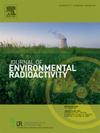Radio-sensitivity of selected namibian landrace groundnut (Arachis hypogaea L.) genotypes to gamma radiation
IF 1.9
3区 环境科学与生态学
Q3 ENVIRONMENTAL SCIENCES
引用次数: 0
Abstract
Groundnut (Arachis hypogaea L.) is a popular nutritious food crop in the world. In Namibia, groundnut varieties are limited and characterized by low yields of 0.4 t/ha. Its production is challenged by biotic and abiotic stresses and low genetic variability in the agroecological zones of Namibia. Gamma-irradiation mutagenesis is a technique applied to generate genetic variation based on the genotype's sensitivity to the mutagenic agent for the selection of traits of economic importance that fulfill the user's requirements. This study aimed to determine the optimal lethal doses (LD50) of mutagens producing maximum mutations with minimum damage for mass gamma-irradiation on Namibian landraces of groundnut in preparation for mutation breeding programs. Seeds of three groundnut varieties (‘NAM 4433’, ‘NAM 888/2', ‘NAM 1747/1’) were subjected to six gamma radiation doses [0, 50, 75, 100, 125, and 150 Gy (Gy)]. The radiation source was Cobalt-60, with an irradiation rate of 28.81 Gy/min. Irradiated and non-irradiated (control) seeds were sown in plastic pots, using a factorial experiment with a randomized complete block design. Data were collected on parameters relating to seed germination, seedling growth, and plant survival of the varieties. A linear regression model was developed to determine the mean lethal dose (LD50) and reduction dose (RD50) of the varieties. Combined analysis of variance showed significant responses (p < 0.001) to seedling emergence, shoot, and root traits. Genotype NAM 4433 was most sensitive to gamma radiation doses ranging from 106 to 150 Gy. The doses could be used in mutation breeding programs to select mutants with desirable agronomic and nutritional traits for farmers and consumers. Genotypes NAM 1747/1 and NAM 888/2 did not respond to the doses applied.
Further research using high radiation doses for NAM 1747/1 and NAM 888/2 is recommended.
纳米比亚地方花生(arachhis hypogaea L.)基因型对伽马辐射的敏感性。
花生(arachhis hypogaea L.)是世界上流行的营养丰富的粮食作物。在纳米比亚,花生品种有限,产量很低,只有0.4吨/公顷。其生产受到生物和非生物胁迫以及纳米比亚农业生态区低遗传变异性的挑战。γ辐照诱变是一种根据基因型对诱变剂的敏感性产生遗传变异的技术,以选择符合用户要求的具有经济意义的性状。本研究旨在确定诱变剂的最佳致死剂量(LD50),以产生最大的突变和最小的损害,为纳米比亚花生地方品种的突变育种计划做准备。对3个花生品种(‘NAM 4433’、‘NAM 888/2’、‘NAM 1747/1’)的种子进行了6次γ辐射剂量(0、50、75、100、125和150 Gy)的试验。辐射源为钴-60,辐照速率为28.81 Gy/min。采用随机完全区设计的析因试验,将辐照和未辐照(对照)种子播种在塑料罐中。收集了品种种子萌发、幼苗生长和植株成活率等相关参数的数据。建立线性回归模型,确定各品种的平均致死剂量(LD50)和还原剂量(RD50)。综合方差分析显示显著性反应(p
本文章由计算机程序翻译,如有差异,请以英文原文为准。
求助全文
约1分钟内获得全文
求助全文
来源期刊

Journal of environmental radioactivity
环境科学-环境科学
CiteScore
4.70
自引率
13.00%
发文量
209
审稿时长
73 days
期刊介绍:
The Journal of Environmental Radioactivity provides a coherent international forum for publication of original research or review papers on any aspect of the occurrence of radioactivity in natural systems.
Relevant subject areas range from applications of environmental radionuclides as mechanistic or timescale tracers of natural processes to assessments of the radioecological or radiological effects of ambient radioactivity. Papers deal with naturally occurring nuclides or with those created and released by man through nuclear weapons manufacture and testing, energy production, fuel-cycle technology, etc. Reports on radioactivity in the oceans, sediments, rivers, lakes, groundwaters, soils, atmosphere and all divisions of the biosphere are welcomed, but these should not simply be of a monitoring nature unless the data are particularly innovative.
 求助内容:
求助内容: 应助结果提醒方式:
应助结果提醒方式:


